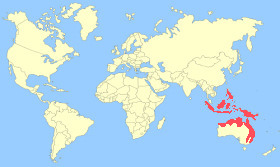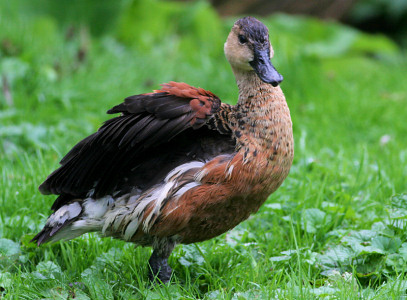Appearance: - The Wandering Whistling Duck has long legs and a long neck. It has a blackish crown and nape, pale brown face with whitish chin, black beak, light-brown speckled breast, rich red-brown underparts and flanks, white undertail, dark black and chestnut upperparts, and the legs and feet are dark. Both sexes are alike.
Size: - Typical Adult is 54-60cm (21-23in).
Food: - Mainly aquatic vegetation, seeds, grasses, weeds and small aquatic animals.
Habitat/Range: - Wetlands, flooded grasslands, deep lagoons, swamps, pastures, and ricefields in northern and eastern Australia, Philippines, Indonesia, and Papua New Guinea.

 Breeding Habitat/Resident,
Breeding Habitat/Resident,  Migration or Winter Area.
Migration or Winter Area.Breeding Season: - January to April.
Eggs: - 6 to 15 (creamy-white colour).
Notes: - The Wandering Whistling Duck is also sometimes called the Tree Duck. As with other Whistling Ducks it has a noisy call. They enjoy being in the water and rarely leave the shore. There are three sub-species - Indonesian Wandering Whistling Duck (Dendrocygna Arcuata Arcuata), Australian Wandering Whistling Duck (Dendrocygna Arcuata Australis), and the New Britain Wandering Whistling Duck (Dendrocygna Arcuata Pygmaea).
Conservation status (IUCN 3.1):
Least Concern.
Classification: - Family: Anatidae,
Subfamily: Dendrocygninae,
Genus: Dendrocygna.

























